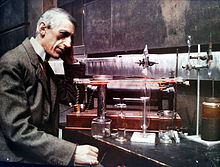J. Norman Collie
| J. Norman Collie | |
|---|---|
 |
|
| Born |
10 September 1859 Alderley Edge, Cheshire, England |
| Died | 1 November 1942 (aged 83) Sligachan, Isle of Skye, Scotland |
| Citizenship | British |
| Notable awards | Fellow of the Royal Society |
Prof John Norman Collie FRSE FRS (10 September 1859 – 1 November 1942), commonly referred to as J. Norman Collie, was a British scientist, mountaineer and explorer.
He was born in Alderley Edge, Cheshire, the second of four sons to John Collie and Selina Mary Winkworth.
In 1870 the family moved to Clifton, near Bristol, and John was educated initially at Windlesham in Surrey and then in 1873 at Charterhouse School. The family money had been made in the cotton trade, but in 1875 the American Civil War resulted in their financial ruin when their American stock was burnt. Collie had to leave Charterhouse and transfer to Clifton College, Bristol where he realised he was completely unsuited for the classics. He attended University College in Bristol and developed an interest in chemistry.
He earned a PhD in chemistry under Johannes Wislicenus at Wurzburg in 1884. Returning to Britain, he taught three years at Cheltenham Ladies College where, according to his niece, "he was far from being a ladies' man and probably found that schoolgirls in bulk were rather more than he could stomach". He left to join University College London (UCL) as an assistant to William Ramsay. His early work was the study of phosphonium and phosphine derivatives and allied ammonium compounds. Later he made important contributions to the knowledge of dehydracetic acid, describing a number of very remarkable 'condensations,' whereby it is converted into pyridine, orcinol and naphthalene derivatives.
Collie served as Professor of Organic Chemistry at UCL from 1896 to 1913, and headed its chemistry department from 1913 to 1928. He performed important research that led to the taking of the first x-ray for diagnosing medical conditions. According to Bentley, Collie "worked with Ramsay on the inert gases, constructed the first neon lamp, proposed a dynamic structure for benzene, and discovered the first oxonium salt." The work on neon discare lamps was conducted in 1909. The effect of glowing neon in contact with mercury was later some times called Collier effect.
...
Wikipedia
